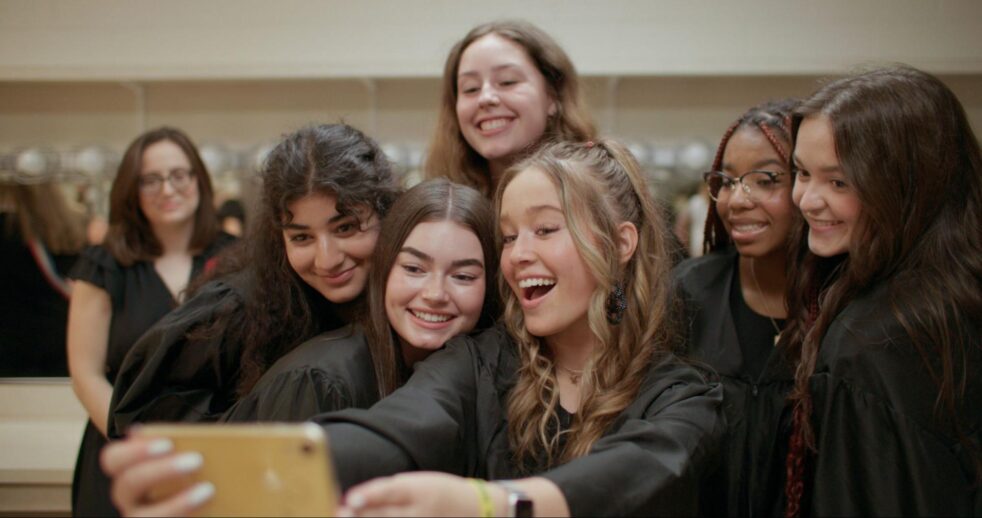Imagine taking a week to create an entirely new system of government with all the same capabilities and power struggles present today.
Apple TV’s “Girls State,” directed by Jesse Moss and Amanda McBaine, follows the experience of a few select girls as they attend Missouri’s all-girls program to form their own system of government and campaign to run for its positions.
Coming off the production of “Boys State,” the 2020 predecessor exploring the all-boys program in Texas, this 2024 documentary explores the intersection of democracy and feminism through the perspective of high school women. The American Legion is a selective educational program that hosts an interactive experience for politically-nuanced students wanting to excel in politics. The film highlights the experiences of a few select girls and how their journey from arrival to departure ensues. In capturing the program the same way the attendees interact with it, “Girls State” bridges the gap between observational remarks and first-hand insights that bolster its messaging and illuminate areas of issue within a program promoting female empowerment.
Most years see the boys’ and girls’ programs in separate states. However, “Girls State” features a rare occurrence of both programs being hosted on the same site, which introduces comparison and issues of sexism within the program itself into the film.
Directors Moss and McBaine gave insight on the nuances of “Girls State” and its filming in an interview with the Technique.
The question of ethical documentary work is an industry favorite, as many films simply insert themselves into the experiences of others. “Girls State” realizes this and actively works to counteract it. Both Moss and McBaine ensured the filming was not too invasive by simply “building trust,” Moss said.
“We’re asking a lot from them … the girls we selected, we love because they’re ambitious, they’re smart, but they’re also really open to the camera, and that’s not everybody,” Moss said.
Since this program caters to high-school children, the girls were minors, so parental communication and overall understanding of the documentary process were key to its success and respectfulness.
Another major decision was the film crew. Moss noted, “We built a largely female crew. That was really important for us to be mindful of the gaze and intimate space and public space they were moving through.” The focus was not solely on content but the relationship with the cast and respecting the moments that did not need to be filmed or shared. Rather than releasing the documentary after its completion, “Girls State” was shared with the girls and their families to solicit input and address any concerns they held.
Just as much as “Girls State” experiences the girls’ program, it also lives through the inequities. While the goal of the film was not to compare the girls versus boys program, it started to come about naturally.
“I kind of got a sense for there being a little bit of difference between the programs, but we didn’t spend a lot of time thinking [about] that. I also knew going in that female representation in the adult state, in the real world, is not the same as male representation, so it was going to be a question mark in my mind going into the program,” McBaine said.
Even with this question on their minds, the decision to host the boys state program parallel to the girls’ wasn’t a known factor.
“That’s a good moment to be there as a filmmaker. That’s exciting because it’s an unknown for the program too,” McBaine said.
The differences between both programs jumped out almost immediately. While the men in Boys State began political debates and conversations the moments they arrived, the Girls State attendees were given cupcake decorating and lounge hours, leaving the politically-charged moments for a couple days in.
Moss admitted, “I naively assumed the programs would be identical. In hindsight, I shouldn’t have assumed that. Of course there were inequities. They are both eight years old, but we didn’t know they had different resources and fundamentally different structures and approaches to the week.”
One key difference is where the boys and girls see their futures.
“All the girls wanted to be on the Supreme Court. That was a very competitive space,” McBaine said. “And the answer is kind of clear to me that in the real world, the Supreme Court is a represented space for women, and governorships/presidency are not as much.”
The majority of cases heard within the girls program and one of the most common platforms within campaigns fell on the issue of abortion as the leaked draft overturning Roe v. Wade was made public at the beginning of the week. With both programs at the same campus, the girls also shed light on the inequalities between them. This conversation dominates the second half of the film, as an investigative piece written by one of the attendees reveals large disparities in funding and workers as well as experiences with active politicians.
“Girls State” excels as a next-level documentary walking its audience through the political landscape of the next generation. The film delves into social and program issues that reinforce the inequalities faced by women across platforms and experiences. Its use of firsthand, high school perspectives builds a sense of hopefulness towards the political future and introduces a refreshing awareness of girls across the country.
